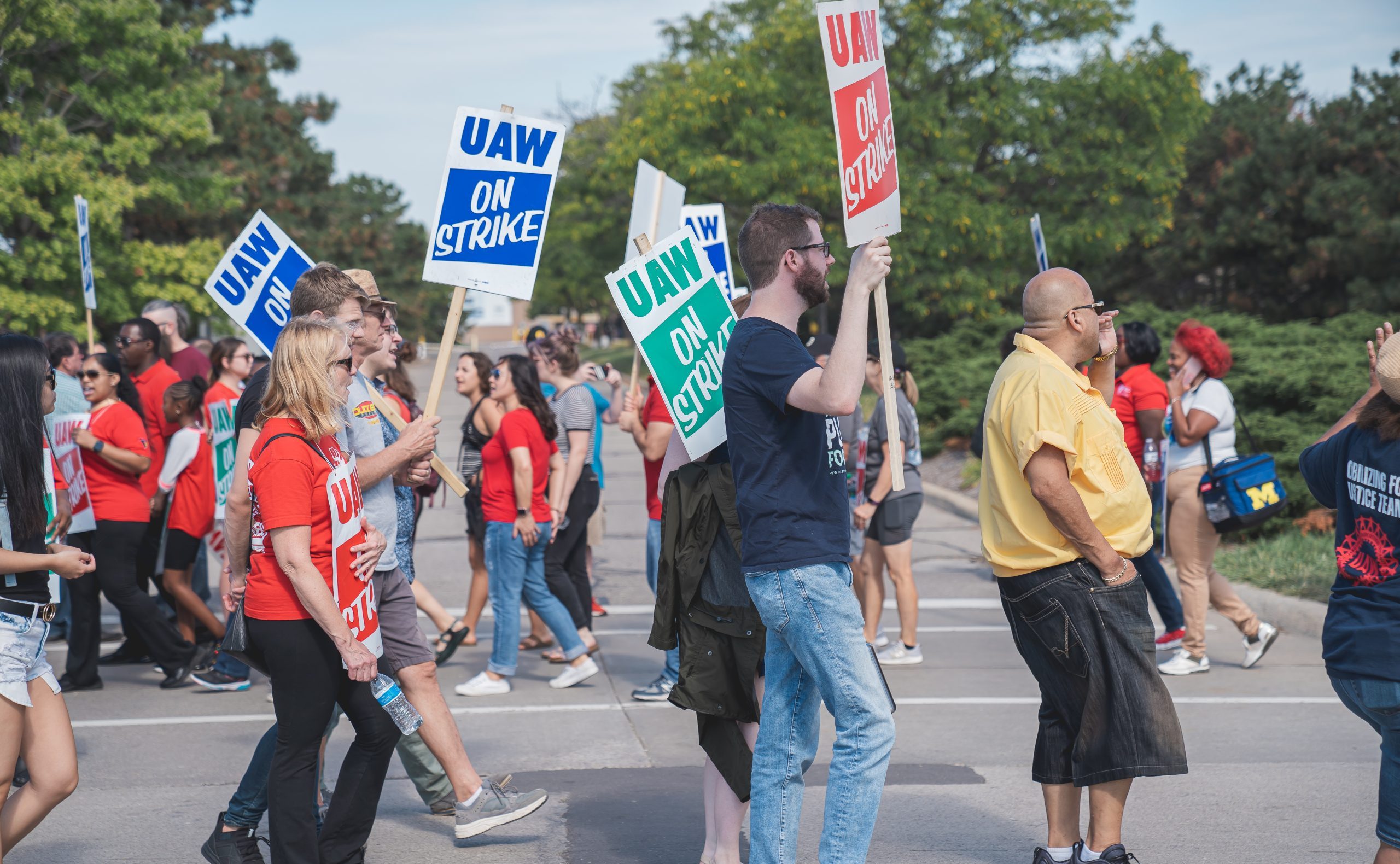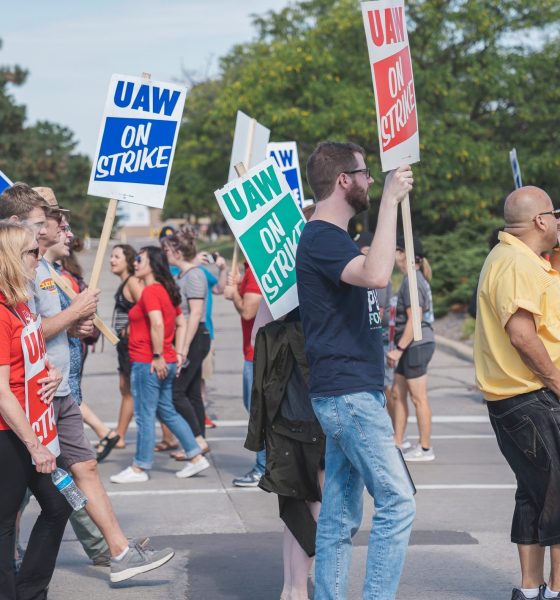Despite making some progress in contract negotiations with the United Auto Workers (UAW) union, Ford says there are still some major gaps to address before an agreement is reached. The statement comes after Ford avoided escalated strikes by meeting some UAW demands last week, just as parts workers walked out of 38 Stellantis and General Motors (GM) distribution centers on Friday.
Ford said on Sunday that there were still “significant gaps to close” in contract negotiations with the UAW, according to a report from Reuters. The UAW said it made “some real progress at Ford” over the weekend, although it added that the two parties still had serious issues to work through.
On Sunday evening, Ford said the related “issues are interconnected and must work within an overall agreement that supports our mutual success.”
At the time of writing, the UAW has not yet commented on the statement from Ford. The news also comes ahead of U.S. President Joe Biden’s plans to visit Michigan in support of the strikes on Tuesday.
Ford also said that it would be pausing construction on a $3.5 billion battery manufacturing plant in Michigan, as detailed in a Monday afternoon report from Reuters.
“We are pausing work and limiting spending on construction on the Marshall project until we’re confident about our ability to competitively operate the plant,” Ford said. “We haven’t made any final decision about the planned investment there.”
The Detroit automakers have offered contracts with 20-percent raises over the next four and a half years, though the UAW is reportedly still asking for 40-percent wage hikes over a four-year period, in addition to 32-hour work weeks. The union is also demanding the restoration of defined pension benefits and an end to a tiered wage system that requires a certain amount of time to reach top wages.
Workers at an additional 20 Stellantis and 18 GM parts distribution centers walked off the job on Friday due to a lack of progress in UAW contract negotiations. The walkouts are straining other Stellantis and GM manufacturing facilities, rendering them unable to receive the necessary parts to continue production. The expanded strikes totaled around 5,600 workers, joining the initial wave of 12,700 workers who walked out a week prior.
The UAW represents roughly 150,000 workers total, and this is the first time in history that the union has lodged strikes against all three of the Michigan automakers simultaneously.
“Like the rest of us all, all we’re asking is to not have to struggle. Just wanting enough money to pay my bills, buy groceries, and have enough for extras like taking my kid to the jump park.”– Samantha Richter, a worker at Ford Michigan Assembly Plant https://t.co/pCgxP36QWo
— UAW (@UAW) September 25, 2023
Last week, GM said it was forced to lay off around 2,000 workers at a Fairfax, Kansas plant, citing a lack of available work due to the UAW strikes. The automaker went on to call the UAW demands “untenable,” adding that it wouldn’t be able to offer unemployment for the laid-off employees.
As the Detroit Free Press reports, one auto supplier in Wixom, Michigan also announced plans to lay off 230 workers on Monday. The figure represents 75 percent of employees at Eagle Industries, Inc., which makes a material used in car door components along with other non-automotive products. While the company hasn’t explicitly disclosed its clients, a separate analysis noted that its product had been used in Ford’s vehicles.
“As a result of unforeseen business circumstances, we are providing information in anticipation of a potential layoff at the worksite,” wrote the company in a note to the state of Michigan. “The estimated number of workers is subject to change due to evolving business circumstances.”
Some predict that the ongoing strikes will likely result in higher vehicle prices due to increased costs for parts. Another analysis from the University of Michigan noted that as many as 150,000 workers could be subject to layoffs if the strikes last an entire month, highlighting the situation’s far-reaching effects until the parties can finalize a deal.
“These growing spillover effects across the automotive supply chain produce successively larger spillovers to the broader economy, as well,” states the analysis, “as laid-off workers in the supply chain lose purchasing power and cut back on spending in other parts of the economy.”
Update: Updated to include the Monday afternoon report from Reuters, in which Ford said it was pausing construction on a Michigan battery plant.
What are your thoughts? Let me know at zach@teslarati.com, find me on X at @zacharyvisconti, or send your tips to us at tips@teslarati.com.

News
Tesla FSD fleet is nearing 7 billion total miles, including 2.5 billion city miles
As can be seen on Tesla’s official FSD webpage, vehicles equipped with the system have now navigated over 6.99 billion miles.

Tesla’s Full Self-Driving (Supervised) fleet is closing in on almost 7 billion total miles driven, as per data posted by the company on its official FSD webpage.
These figures hint at the massive scale of data fueling Tesla’s rapid FSD improvements, which have been quite notable as of late.
FSD mileage milestones
As can be seen on Tesla’s official FSD webpage, vehicles equipped with the system have now navigated over 6.99 billion miles. Tesla owner and avid FSD tester Whole Mars Catalog also shared a screenshot indicating that from the nearly 7 billion miles traveled by the FSD fleet, more than 2.5 billion miles were driven inside cities.
City miles are particularly valuable for complex urban scenarios like unprotected turns, pedestrian interactions, and traffic lights. This is also the difference-maker for FSD, as only complex solutions, such as Waymo’s self-driving taxis, operate similarly on inner-city streets. And even then, incidents such as the San Francisco blackouts have proven challenging for sensor-rich vehicles like Waymos.
Tesla’s data edge
Tesla has a number of advantages in the autonomous vehicle sector, one of which is the size of its fleet and the number of vehicles training FSD on real-world roads. Tesla’s nearly 7 billion FSD miles then allow the company to roll out updates that make its vehicles behave like they are being driven by experienced drivers, even if they are operating on their own.
So notable are Tesla’s improvements to FSD that NVIDIA Director of Robotics Jim Fan, after experiencing FSD v14, noted that the system is the first AI that passes what he described as a “Physical Turing Test.”
“Despite knowing exactly how robot learning works, I still find it magical watching the steering wheel turn by itself. First it feels surreal, next it becomes routine. Then, like the smartphone, taking it away actively hurts. This is how humanity gets rewired and glued to god-like technologies,” Fan wrote in a post on X.
News
Tesla starts showing how FSD will change lives in Europe
Local officials tested the system on narrow country roads and were impressed by FSD’s smooth, human-like driving, with some calling the service a game-changer for everyday life in areas that are far from urban centers.

Tesla has launched Europe’s first public shuttle service using Full Self-Driving (Supervised) in the rural Eifelkreis Bitburg-Prüm region of Germany, demonstrating how the technology can restore independence and mobility for people who struggle with limited transport options.
Local officials tested the system on narrow country roads and were impressed by FSD’s smooth, human-like driving, with some calling the service a game-changer for everyday life in areas that are far from urban centers.
Officials see real impact on rural residents
Arzfeld Mayor Johannes Kuhl and District Administrator Andreas Kruppert personally tested the Tesla shuttle service. This allowed them to see just how well FSD navigated winding lanes and rural roads confidently. Kruppert said, “Autonomous driving sounds like science fiction to many, but we simply see here that it works totally well in rural regions too.” Kuhl, for his part, also noted that FSD “feels like a very experienced driver.”
The pilot complements the area’s “Citizen Bus” program, which provides on-demand rides for elderly residents who can no longer drive themselves. Tesla Europe shared a video of a demonstration of the service, highlighting how FSD gives people their freedom back, even in places where public transport is not as prevalent.
What the Ministry for Economic Affairs and Transport says
Rhineland-Palatinate’s Minister Daniela Schmitt supported the project, praising the collaboration that made this “first of its kind in Europe” possible. As per the ministry, the rural rollout for the service shows FSD’s potential beyond major cities, and it delivers tangible benefits like grocery runs, doctor visits, and social connections for isolated residents.
“Reliable and flexible mobility is especially vital in rural areas. With the launch of a shuttle service using self-driving vehicles (FSD supervised) by Tesla in the Eifelkreis Bitburg-Prüm, an innovative pilot project is now getting underway that complements local community bus services. It is the first project of its kind in Europe.
“The result is a real gain for rural mobility: greater accessibility, more flexibility and tangible benefits for everyday life. A strong signal for innovation, cooperation and future-oriented mobility beyond urban centers,” the ministry wrote in a LinkedIn post.
News
Tesla China quietly posts Robotaxi-related job listing
Tesla China is currently seeking a Low Voltage Electrical Engineer to work on circuit board design for the company’s autonomous vehicles.

Tesla has posted a new job listing in Shanghai explicitly tied to its Robotaxi program, fueling speculation that the company is preparing to launch its dedicated autonomous ride-hailing service in China.
As noted in the listing, Tesla China is currently seeking a Low Voltage Electrical Engineer to work on circuit board design for the company’s autonomous vehicles.
Robotaxi-specific role
The listing, which was shared on social media platform X by industry watcher @tslaming, suggested that Tesla China is looking to fill the role urgently. The job listing itself specifically mentions that the person hired for the role will be working on the Low Voltage Hardware team, which would design the circuit boards that would serve as the nervous system of the Robotaxi.
Key tasks for the role, as indicated in the job listing, include collaboration with PCB layout, firmware, mechanical, program management, and validation teams, among other responsibilities. The role is based in Shanghai.
China Robotaxi launch
China represents a massive potential market for robotaxis, with its dense urban centers and supportive policies in select cities. Tesla has limited permission to roll out FSD in the country, though despite this, its vehicles have been hailed as among the best in the market when it comes to autonomous features. So far, at least, it appears that China supports Tesla’s FSD and Robotaxi rollout.
This was hinted at in November, when Tesla brought the Cybercab to the 8th China International Import Expo (CIIE) in Shanghai, marking the first time that the autonomous two-seater was brought to the Asia-Pacific region. The vehicle, despite not having a release date in China, received a significant amount of interest among the event’s attendees.










